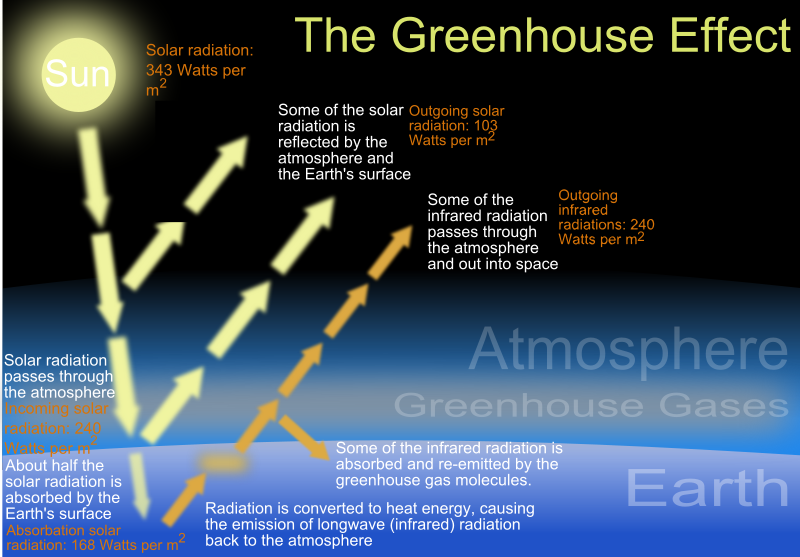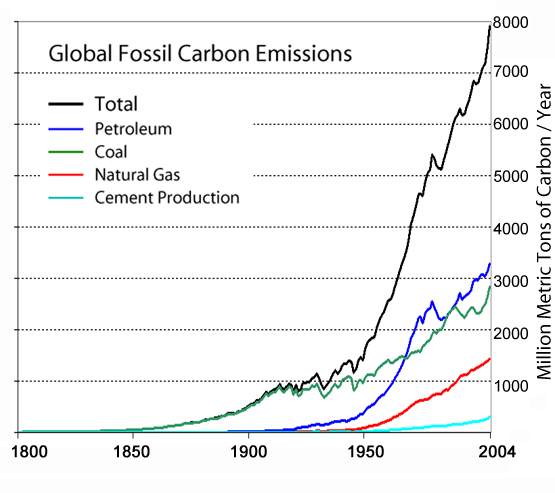However, things in the air can hold on to heat. Gases such as CO2, oxygen, water vapor, and methane all hold onto heat very well. As these gases rise, they deflect the sun's rays back towards the Earth, rather than back out of the atmosphere. This obviously greatly increases the temperature of the Earth, which is the largest factor in determining climate of an area. Heat-trapping mechanisms are natural on Earth, and should be here in order to maintain temperatures on different parts of the Earth. Some do a better job of retaining heart than others. Water vapor is the highest heat-retainer, it contributes about 36-72% of greenhouse effects. Soon after it is carbon dioxide, which contributes about 9-26% (1). It probably isn't a coincidence that these are two things that humans produce through respiration. Carbon dioxide is a large problem due to the large amounts of carbon emissions since the industrial revolution (2).
Items such as the ones listed on the graph above greatly increase the amount of CO2 in the atmosphere, which as said before, holds onto heat extremely well. Another large contributer to global warming, although not the first thing that comes to mind, is cows. Cows release very large amounts of methane, which are also good at retaining heat. It wouldn't be so bad if there weren't as many cows as there are in the world, but as they are raised for consumers, they must be in large quantities, which unfortunately, greatly raises the methane levels in the air. However, things are being done to reduce these elements in the air. New green energy plans include using methane as a power source. Another plan is plants, which bring in carbon dioxide and sun's rays in order to use cellular respiration.
B) Natural mechanisms can also play a large role the climate. Large volcanic eruptions release large amounts of CO2 and they also create extremely vast dust clouds that cover large areas, preventing the sun's rays from reaching the plants and animals that are under the giant cloud. Temperatures drop in these places, and only some species can survive the switch from warmth to cold in such a short period of time.
A large theory about how the dinosaurs became extinct and the last ice age started is that a very large meteorite hit the Earth, which put a lot of sulfur and CO2 in the air, and forming a cloud over a majority of the Earth that prevented light from reaching plants and animals. Soon enough the plants died out due to no sun. This had a large effect on the other animals in several ways. For one, plants produce a majority of the oxygen that other organisms breathe. If all the plants were gone, then there would be hardly any oxygen, so the dinosaurs would have instead been breathing in CO2, which kills animals. The other problem would have been that primary consumers would have had nothing more to eat, and the food chain would have been ended because of that. Once all the energy had left the system, organisms would have been extinct, but their bodies leaving behind all forms of elements in order to make way for primary succession later on.
Bibliography
(1) Kiehl, J. T.; Kevin E. Trenberth (February 1997). "Earth’s Annual Global Mean Energy Budget" (PDF). Bulletin of the American Meteorological Society 78 (2): 197–208. doi:. Retrieved 2009-11-23.
(2)"Climate Change 2001: Working Group I: The Scientific Basis: figure 6-6". Retrieved 2009-11-23





